The Comprehensive Guide to Dating App Development
Manish Kumawat
Last Updated on: 30 September 2025
Here we bring the best dating app development guide to solve all your queries. A remarkable transformation has been witnessed in the world of dating in recent years. The widespread adoption of mobile dating apps has influenced this mainly. The way individuals connect, form relationships, and explore romantic possibilities are redefined by these platforms. Leading dating apps are using unique dating app development strategy and making huge profits. The dating app is the best option for those who want to launch a profitable mobile app. According to forecasting, the rate of user penetration will reach 5.7% by 2028 from 5.1% in 2024.
Are you thinking about how to create and launch a dating app? Here is the perfect dating app development guide. Every aspect of dating app development is available in this dating app development guide including addressing common doubts and exploring the strategies required for success
1. Introduction: The Dating App Revolution
Dating App Landscape
Welcome to the exciting world of modern dating! The Online Dating market size is expected to reach 452,5 million users by 2028. The primary means of meeting new people and finding an ideal partner is now dating apps.
Guaranteed success is waiting for entrepreneurs, startups, and business owners if they get into the dating app industry. It is possible for people to connect, match, and communicate with potential partners from the comfort of their smartphones with mobile dating apps. It is more accessible and engaging than ever before with this convenience.
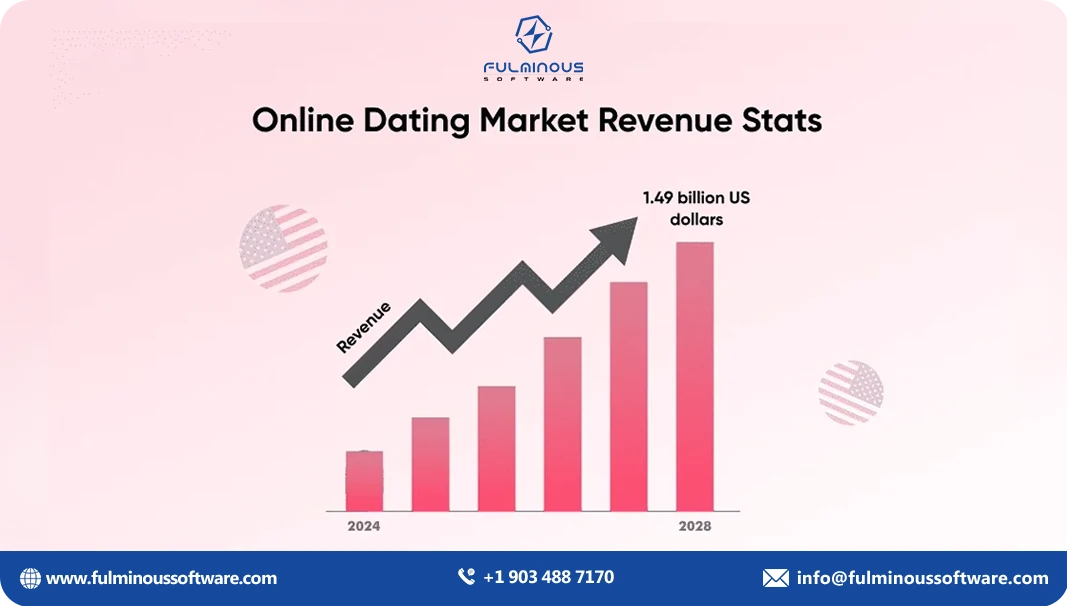
The Promise of Profit
Beyond facilitating connections, The dating app industry is also a profitable business. The revenue from online dating is predicted to reach $66.19 million by 2027. By the end of the decade, at least 10% annual growth in the industry is expected. Investing in dating app development will be a wise decision because the financial potential of this market makes it an attractive proposition. Specific markets based on factors like age, religion, or hobbies demonstrate how flexible and adaptive this sector is. Ideation to monetization, technology stack selection, cost considerations, and more all are discussed in the following sections. For the information and understanding required to effectively deal with the difficulties and take advantage of the opportunities that the dating app market presents, have a deep look at this dating app development guide.
2. Dating App Development: The Building Blocks
Conceptualization and Ideation Phase
Before you start building a dating app, it's crucial to begin with a clear vision. In other words, you need a clear dating app development strategy. For those who ask how to create a dating app from scratch, first focus on answering the following questions:
- What kind of dating app do you want to create?
- Whom you are targeting?
- What are the preferences of the target audience?
- What problem will it solve for users?
Brainstorm ideas, define your target audience, and outline the core features in this ideation phase.
Doubt 1: Is There Room for Another Dating App?
Before investing in dating app development, it is important to answer this common question. The answer is, Yes always, but it depends on your dating app development idea. With numerous dating apps already in existence, you might wonder if the market is oversaturated. While the dating app market is competitive, a unique concept or niche focus can help your app stand out. Successful apps like Bumble are to be considered, which empowered women to make the first move, or Hinge, which focuses on fostering more meaningful connections. In simple words, if you have a unique dating app development idea, you can be the leader of this industry. Some unique dating app development ideas are:
- Video-Dating App
- Dating App Based on Hobbies and Passion
- Dating App for the LGBTQ Community
- Dating App for Seniors
- Dating Apps for Similar Professions
- AI-powered Dating App
- Dating App Based on Horoscope Matching
- Travel-Companion-Based Dating App
- Dating App for Local Connections
Doubt 2: Should I Build a General or Niche App?
Here comes the need for a dating app development strategy. General dating apps like Tinder and Bumble cater to a broad audience, while niche apps focus on specific demographics or interests, such as religious dating apps or apps for seniors. Niche apps can be highly successful because they address the specific needs of a particular group of users. Research your target audience thoroughly to determine which approach is best. Your target audience and your app's unique value proposition should be the base for your decision.
Market Research: Know Your Audience
Successful dating app development hinges on understanding your target audience inside and out. Identify user preferences and the specific features they value most through much-needed market research. Your app's design and development will be effective by this.
Doubt 3: How Do I Conduct Effective Market Research?
Analyzing existing online dating applications to understand their user base, features, and monetization strategies is the first step in creating a successful dating app business plan. Conducting surveys with users helps gather valuable insights into their dating habits and preferences. Additionally, evaluating user reviews and feedback on current apps can help identify common shortcomings. As part of your dating app business plan, it's also essential to perform a thorough competitor analysis to understand what strategies are effective in the current market and where opportunities for innovation lie.
Defining Your Unique Value Proposition
Your app's unique value proposition (UVP) is what sets it apart from the competition and attracts users. It's the answer to the question, "Why should users choose your app over others?" Your UVP could be based on features, user experience, safety measures, or catering to a specific niche.
Doubt 4: What Makes a Strong UVP?
A strong UVP should address a genuine user need or pain point. Unique benefits your app offers should be clearly communicated. For example, if your app focuses on safety and verification, your UVP might be, "The Safest Dating App: Where Genuine Connections Thrive." If your app caters to a specific niche, your UVP might be, "Find Love with Like-Minded Singles Who Share Your Passions."
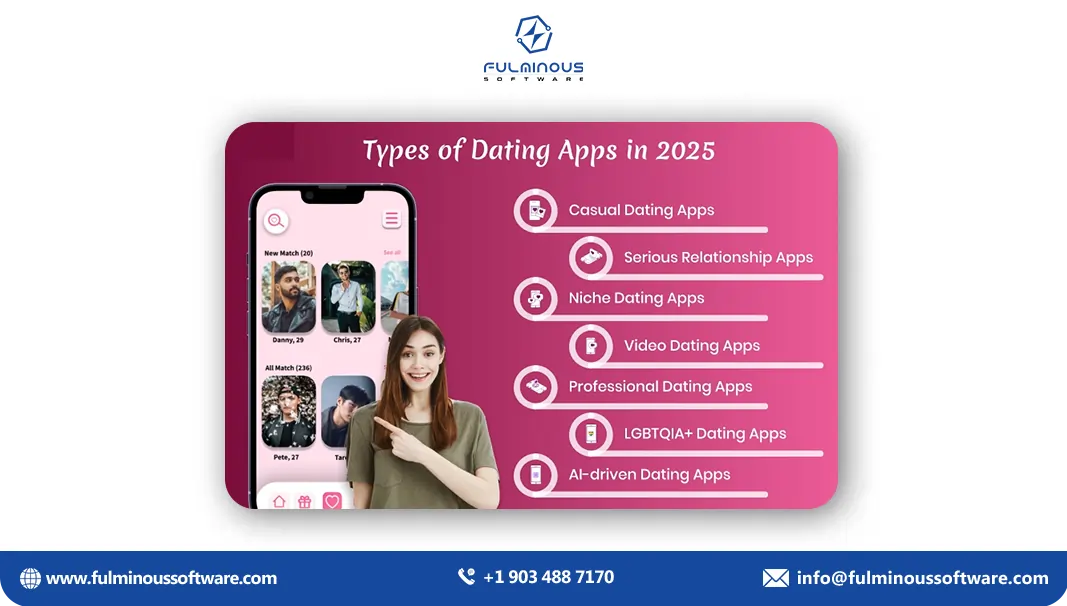
Fulminous Software is a leading dating app development company. To know the right way to get into this industry, ask our experts.
3. Crucial Features for Dating Apps
When you think about How to develop a dating app?, you can't ignore the essential features of successful dating apps. Here we will see it one by one in this section of the dating app development guide.
User Profiles and Authentication
The users begin with User profile creation. So you need to make user profile creation easy. User profile management is the foundation of any dating app. For a showing of their personality, interests, and photos, the user profile management option is mandatory. To ensure that user profiles are genuine and not fraudulent, user authentication is also equally critical. User authentication methods can be email/password, phone OTP, or social logins (Google, Facebook).
Doubt 5: How Do I Authenticate User Profiles?
Email verification, phone number verification, and social media integration are included in the user authentication multi-step process. Email and phone number verification requires users to confirm their identity by entering a code sent to their email or phone. Allows users to import their photos and some profile information from platforms like Facebook with Social media integration.
Doubt 6: What About User Privacy?
Users should have control over the information they share and who can access it. Implement clear privacy settings that allow users to choose what information is visible on their profile and who can contact them.
Know Dating App Algorithm
Dating apps use different types of matching algorithms. Dating app algorithm is the key to bringing the best app performance and user experience. These systems are based on computer technology, psychology, learning from user behavior, and how people interact with the app. The major dating app algorithm are:
- Elo Score Algorithm
- Collaborative Filtering
- Preference Matching Algorithm
- Machine Learning Algorithms
- Geolocation-Based Matching
- Reinforcement Learning Models
- Natural Language Processing (NLP) Algorithms
- Computer Vision Algorithms
- Bayesian Inference Models
- Matrix Factorization
Matching Algorithms: The Heart of the App
Matchmaking algorithms are the secret sauce behind successful dating apps. The various approaches to matching are geolocation-based matching, mathematical algorithms, and AI-driven matchmaking. Implementing AI in dating app algorithms is the latest method to achieve success.
Doubt 7: How Do I Build Effective Matching Algorithms?
The result of a combined data analysis, machine learning, and user feedback is the best matching algorithm. Data on user behaviour, successful matches, and user preferences need to be analysed after collection. Machine learning is useful for refining your algorithms over time.
Messaging and Communication
To interact and get to know each other, users need to provide messaging features. Communication options like voice and video calls are essential along with basic text messaging options.
What algorithm is used in dating apps? How can I improve matching algorithms? This is the major concern of those who want to build dating apps. The result of a combined data analysis, machine learning, and user feedback is the best matching algorithm. Data on user behavior, successful matches, and user preferences need to be analyzed after collection. Implementing AI in dating app algorithms is the key technology to building effective matching algorithms. Machine learning algorithms are useful for refining your algorithms over time. Remember to add trending feature AI-driven recommendations.
Messaging and Communication
These are other important features of successful dating apps. To interact and get to know each other, users need to provide messaging features. Communication options like voice and video calls are essential along with basic text messaging options.
Doubt 8: How Do I Ensure User Safety in Messaging?
The top concern in messaging is user safety . Implement features that allow users to report and block other users in case of inappropriate behaviour. AI and machines can be considered for learning to detect and flag suspicious or harmful messages.
Social Media Integration
An online dating application is a social discovery platform. With the support of a dating application development consultancy, social media integration can be effectively implemented to streamline the profile creation process and enhance user authenticity. By leveraging this feature, users can import photos and some profile information from their existing social media accounts, making onboarding faster and more reliable.
Doubt 9: Are There Privacy Risks with Social Media Integration?
Addressing privacy concerns is essential while social media integration offers convenience. Ensure that users have full control over which social media information they share and that the integration process is secure and compliant with privacy regulations.
Privacy and Security Measures
User safety and data privacy are paramount in dating apps. To protect user information from breaches, Implement robust security measures, including end-to-end data encryption for messages and user data. You can use Blockchain for data security. Also, you need to add user reporting and blocking features to keep your dating app safe. User reporting and blocking features bring more trust in users.
Doubt 10: How Do I Comply with Data Privacy Regulations?
Regulatory compliance (e.g., GDPR) is crucial. Option to delete their accounts and data permanently must be given for users to ensure that your app's data handling practices are transparent.
Gamification: Making Dating Fun
Gamification elements, such as swiping or liking profiles, make the dating experience more interactive and enjoyable for users. Encourage engagement and keep users coming back using these features.
Doubt 11: How Can Gamification Be Implemented Effectively?
Effective gamification should be intuitive and add value to the user experience. It should not feel forced or overly competitive. Test different gamification elements to see what resonates best with your target audience.
Advanced Search and Filtering Options
Providing users with advanced search and filtering options helps them find potential matches based on specific criteria such as age, location, interests, and more. Allow users to narrow down their choices so that the user experience will be enhanced.
Doubt 12: How Do I Balance Simplicity and Complexity in Search Features?
Simplicity and complexity should be balanced in search features as essential. Offer basic search options for users who prefer simplicity, but also provide advanced filters for those who want to fine-tune their search criteria. The various strategies for monetizing your dating app are discussed below, as profitability is a key consideration in app development.
Geolocation in dating apps
Geolocation in dating apps helps users find potential matches nearby by using their current location. Apps like Tinder, Bumble, and Happn use Geolocation services to suggest people within a certain distance. Geolocation in dating apps increases the chances of real-life meetings and builds connections based on proximity.
Real-time chat integration
Real-time chat integration in dating apps allows users to instantly send and receive messages. For live conversations without delays, real-time chat/messaging enhances user engagement by enabling smooth.
Swipe Feature
Swipe feature implementation lets users like or skip profiles by swiping left or right. This brings a feeling in users like everything in their fingertips. Swipe functionality needs touch gestures and user input tracking.
Push Notifications Setup
In your Social discovery platform, push notifications setup keeps users updated with messages, matches, or app activity using services like Firebase or Apple Push Notification Service.
Video/Voice Calling Feature
Video and voice calling features let users connect directly through the dating app, offering a more personal and interactive way to communicate safely.
Safety and Privacy Tools
Safety tools include profile verification, report/block options, and privacy settings to control visibility, ensuring a secure and respectful user experience.
Community Building Features
Community features like forums, group chats, events, and interest-based communities help users engage beyond one-on-one chats, building a sense of belonging.
Data Encryption Techniques
Data encryption techniques protect user data by converting it into unreadable code using methods like SSL/TLS, AES, or RSA for safe storage.
Third-Party API Integration
Third-party API integration adds extra features like maps, chats, or payments by connecting external services to the app through code.
User Feedback Mechanisms
User Feedback Mechanisms like in-app surveys, rating systems, and report options let users share opinions or flag issues, helping improve app quality and trust.
Want to make your dating app more unique?
Then you need to consider the following two features:
- Augmented reality (AR) features
- Virtual reality (VR) dating experiences
Both these features bring a real-life experience to users through your app. Augmented Reality (AR) features add interactive filters, avatars, or games to enhance dating profiles, while Virtual Reality (VR) dating experiences create immersive virtual date environments for realistic, remote social interaction. As the trend moves toward more personalized and tech-enhanced connections, features like these are expected to play a major role in AI-powered dating apps 2025 and beyond.
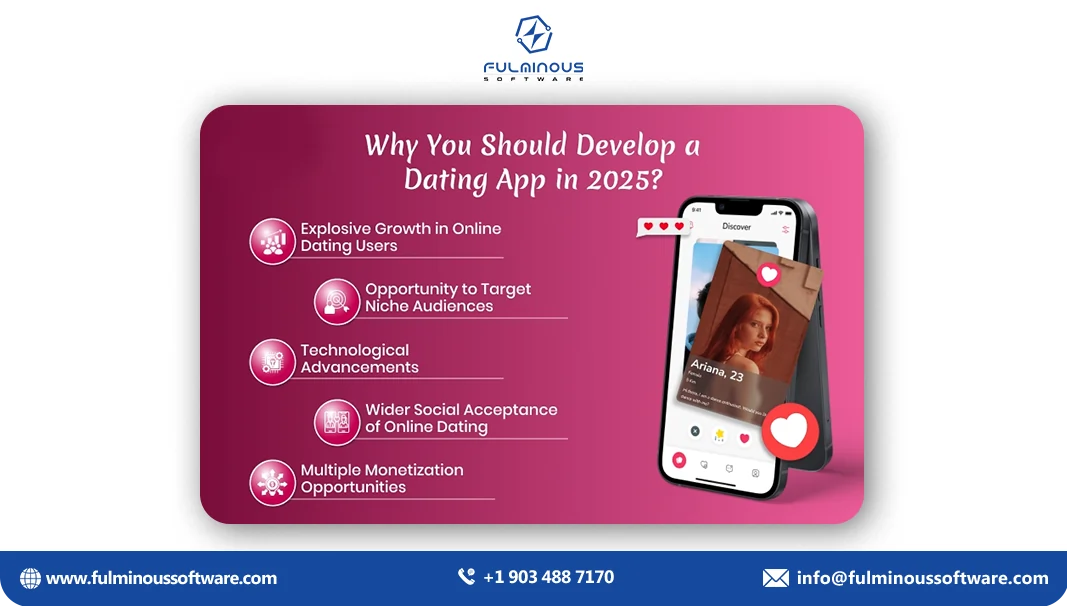
A feature-rich dating app is what Fulminous promises—crafted by the best dating app developers. Why wait? Connect with us now.
4.Monetization Strategies for Dating Apps
Here comes the most important part of this dating app development guide- monetization strategies for dating applications. This is the key to making money.
Subscription Model
The subscription models involve offering premium subscription plans with additional features and benefits for users willing to pay a monthly or annual fee.
Doubt 13: What Features Can Be Included in Premium Subscriptions?
ad-free browsing, unlimited likes or swipes, access to advanced filters, and the ability to see who liked their profile can be added to Premium features.
In-App Advertising: The Art of Balance
In-app advertising generates revenue by displaying targeted advertisements within the app. Ads and user experience are to be balanced essentially.
Doubt 14: How Can I Ensure Non-Intrusive Ads?
Consider implementing native ads that seamlessly blend with the app's design to ensure non-intrusive ads. Allow users to opt out of personalized ads and provide clear options to remove ads through in-app purchases or premium subscriptions.
In-App Purchases: Adding Value
In-app purchases allow users to buy virtual goods or premium features within the app, such as virtual gifts or boosts to increase visibility.
Doubt 15: What Virtual Goods Can Be Offered?
Virtual goods can include items like virtual gifts, stickers, or tokens that users can send to their matches as a form of expression. The source of revenue is assured by these goods.
Partnerships and Sponsorships
Collaborating with relevant brands or businesses to promote their products or services within the app can be a lucrative monetization strategy
Doubt 16: How Do I Choose the Right Partnerships?
Select partnerships that align with your app's niche or target audience. For example, if your app focuses on fitness enthusiasts, partner with fitness brands for promotions and sponsorships.
While choosing monetization strategies for dating applications, conduct a study on what your users expecting.
Freemium Offerings: Basic to Premium
Freemium offerings provide users with free access to basic features, while advanced tools like unlimited swipes or detailed match insights—require payment.
Advertising Integration: Monetizing User Attention
Advertising integration shows ads within the app using platforms like Google AdMob or Facebook Ads, helping generate revenue without charging users directly.

5. Technology Stack: The Foundation of Success
React Native: A Cross-Platform Powerhouse
React Native is a cross-platform framework for building mobile apps. Code reusability is offered by it, allowing developers to write code once and deploy it on both iOS and Android platforms.
Doubt 17: Why Choose React Native?
Efficiency and cost-effectiveness are the highlights of React Native. Faster development, minimum development time and costs, and consistent user experience across platforms are what React Native offers. .
Node.js: The Real-Time Backbone
Node.js is a runtime environment for server-side development. Option for handling real-time communication and data processing making it ideal for dating apps with messaging features.
Doubt 18: How Does Node.js Enhance Real-Time Messaging?
Node.js's event-driven architecture enables real-time messaging through features like chat. Messages are delivered promptly by this, enhancing user engagement.
Golang and Python: Alternatives Worth Exploring
While React Native and Node.js are popular choices, Golang and Python offer unique advantages. It is suitable for high-performance dating apps as speed and efficiency is the highlight of Golang. The versatility and extensive library support of Python make it the best option.
Doubt 19: When Should I Consider Golang or Python?
Consider Golang if you need a fast and efficient backend for real-time communication. Data analysis, machine learning, or AI-driven features can be added to your app with Python. A critical aspect of cost considerations in matchmaking app creation is discussed below.
Fulminous promises maximum RIO by adding monetization to your dating app. Well-planned monetization strategies from Fulminous can change your overall growth pattern.
6. The Cost of Dating App Development
The cost of dating app development can vary significantly based on several factors, especially when building a geolocation dating app . These factors include the complexity of features, the choice of technology stack, the target platform (iOS, Android, or both), and the geographic location of the development team. Incorporating advanced functionalities like real-time location tracking, intelligent matching algorithms, and secure messaging can also increase the overall development budget.
Doubt 20: What Factors Influence Development Costs?
The cost of developing a dating app is influenced by the following factors:
- Features: The more complex and extensive the features, the higher the development costs.
- Design:Designing a user-friendly dating app interface influences the cost. High-quality UI/UX design may require more design resources.
- Platform: Developing for both iOS and Android increases costs compared to a single platform.
- Location: Development costs can vary based on the location of your development team. Offshore development teams may offer cost savings.
Considering various factors, the estimated cost range for developing a dating app falls within $10,000 to $80,000.
Doubt 21: How Can I Set a Realistic Budget?
Your app's feature set and complexity are to be defined in the initial step for a cost-effective budget. Obtain quotes from development teams or freelancers, and factor in ongoing maintenance and updates. initial development, long-term support, and post-launch maintenance to be considered in budgeting. Dating app development services at affordable prices is what Fulminous offers. Book your appointment now to get cost-effective dating apps.
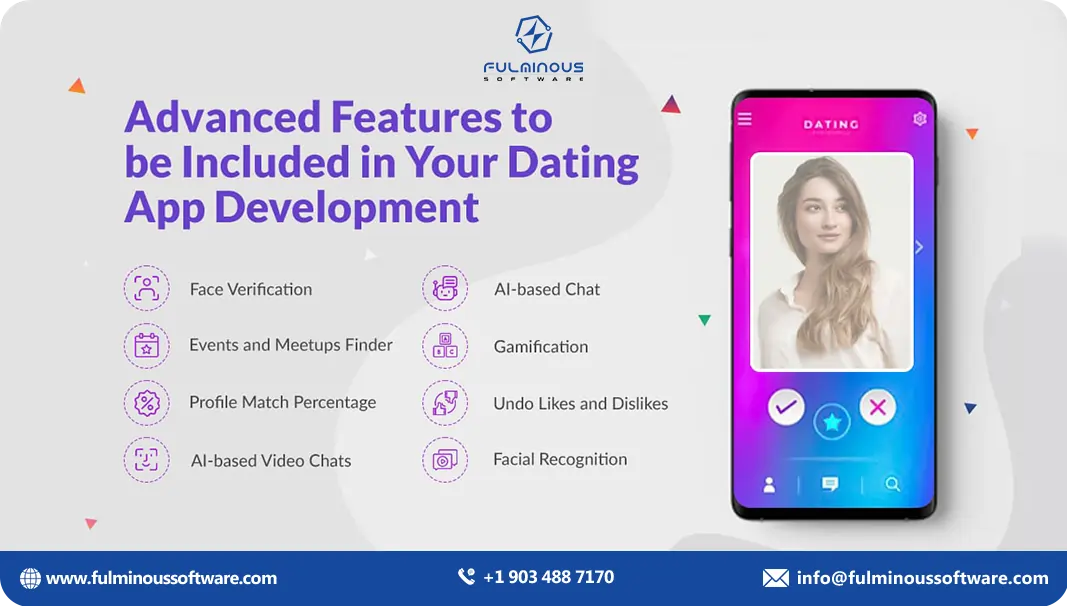
7. Step-by-Step Guide to Building a Successful Dating App
The first thing that comes to mind when you get into dating app development is How to Create a Dating App: Steps. That is why you need a step-by-step guide to developing a dating app. The dating app development process can be understood by step by step process. In this section of the dating app development guide, we will see it.
Step 1: Market Research
Confused about how to create a dating app from scratch? Thoroughly researching your target audience, competitors, and industry trends is the first step of the dating app development process. User behavior and preferences data to be collected. User behavior analysis helps to add exceptional features to your app.
Doubt 22: How Do I Analyze Competitors?
App features, user reviews, and app store rankings of competitors to be studied. Areas, where competitors fall short, are to be noted, and use this information to differentiate your app.
Doubt #23: Should I Start with a Minimum Viable Product (MVP)?
Starting with an MVP is a common approach in app development. Build a basic version of your app with essential features, test it with users, and iterate based on feedback. Minimise risk and development costs with this.
Step 2: Designing the UI/UX
If you want to provide a top personalized user experience, you need to work more on this stage. Designing a user-friendly dating app interface is a crucial stage of the development process. Create an intuitive and visually appealing dating app user interface and user experience (UX) design.
Simplicity, ease of navigation, and visually appealing elements are to be focused on user interface (UI) design. Prototype and test the relationship app design to ensure a seamless user experience. User experience (UX) optimization is also part of this stage.
Doubt 24: How to Ensure Accessibility and Inclusivity in Relationship App Design?
Have a strong study on trending dating app user interface. Test your app with users of all backgrounds to identify any usability issues. Accessibility guidelines can ensure that your user interface (UI) design is accessible to all kinds of users.
Step 3: Prototyping and Wireframing
The third step of the dating app development process is prototyping and wireframing. It can be understood as the visual blueprint of the app. Design low to high-fidelity wireframes to map out user journeys, app layout, and interface structure before development begins.
Benefits of Prototyping and Wireframing in Dating App Development:
- Visual Clarity
- Improved User Experience
- Early Feedback
- Saves Time & Cost
- Better Collaboration
- Faster Development
- Identifies Flaws Early
Step 4: Backend Development
The third step of the dating app development process is backend development. It can be understood as Dating app architecture. Develop the backend infrastructure, including server setup, database management, and integration of necessary APIs for messaging, notifications, and user authentication.
See dating app backend technologies
7 popular dating app backend technologies used are:
- Node.js
- Express.js
- Django (Python)
- Ruby on Rails
- Laravel (PHP)
- Spring Boot (Java)
- Firebase
Doubt 25: How Do I Choose a Reliable Hosting Solution?
Choose a hosting solution based on your app's scalability requirements. Cloud hosting services like AWS, Google Cloud, or Azure are best for scalability and reliability.
Step 5: Frontend Development
Once you build Dating app architecture, it's time for frontend development. Build the frontend components, including user profiles, search and matching features, messaging interfaces, and other interactive elements. Ensure that the front end is responsive and performs well on both iOS and Android platforms.
See dating app frontend technologies
8 frontend technologies commonly used for dating app development are:
- React.js
- Flutter
- Angular
- Vue.js
- Swift (iOS)
- Kotlin (Android)
- React Native
- jQuery
Doubt 26: What's the Role of Cross-Platform Development?
Cross-platform compatibility is key in dating apps. Cross-platform development frameworks like React Native allow you to write code once and deploy it on multiple platforms, saving development time and costs
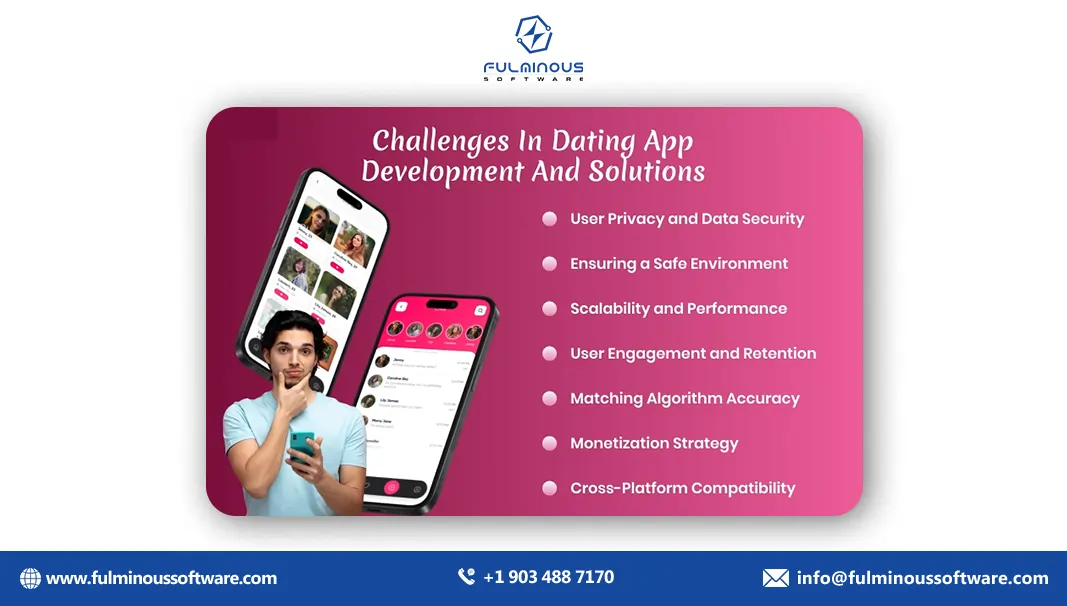
Step 6: Testing and Deployment
Testing and quality assurance come first and then deployment. Thoroughly test the app for bugs, usability, and security vulnerabilities during testing and quality assurance. Conduct usability testing with real users to identify areas for improvement. Deployment and launch to app stores, such as the Apple App Store and Google Play Store also need careful guidance from experts.
Doubt 27: How Do I Handle User Feedback During Testing?
Feedback and report issues options must be provided for users during testing. Work according to user feedback and improve the user experience.
Step 7: Continuous Improvements and Updates
Your answer for how to build a dating app from scratch doesn’t finish with the launch of the app. Post-launch maintenance is also relevant. Continuously collect user feedback and analyze app usage data to identify areas for improvement. Regular updates and new features are important based on user feedback and emerging market trends.
Doubt 28: How Do I Prioritise Feature Updates?
Regular updates and new features are the secret to stay as a leader in the industry. Prioritise feature updates based on user feedback and data analytics. Focusing on improvements to increase user experience, and grow your app's unique value. Common doubts and questions related to matchmaking app creation, including user safety, legal considerations, and data handling are addressed in the next section.
8. Common Doubts and Questions About Dating App Development
In this stage of the dating app development guide, we will answer your major concerns.
How to Handle User Safety and Privacy?
Always follow best practices for dating app security. Online dating application completely depend on user safety and privacy. Inappropriate activities of users can be prevented by adding reporting and blocking options. Provide clear privacy settings that allow users to control their information. Content moderation also plays an important part in this.
Doubt 29: How Do I Handle Sensitive User Data?
Handle sensitive user data with care. Encryption and secure storage practices are to be added to protect user data from breaches. Comply with data privacy regulations and allow users to delete their accounts and data permanently if they choose to do so.
What About User Support?
Address questions, issues, or concerns of users with smooth customer service. Offer a frequently asked questions (FAQ) section and responsive customer support channels, such as email or chat.
Doubt 30: How Do I Deal with Content Moderation?
Adhere to community guidelines and avoid inappropriate content with content moderation. Implement automated content moderation tools and processes to identify and remove violating content.
Are There Legal Considerations?
Yes, there are legal considerations in dating app development. Data privacy regulations, such as GDPR, need to be ensured in your app. Create clear terms of service and privacy policies that users must agree to when using your app.
Doubt 31: How Do I Protect My App's Intellectual Property?
Protect your app's intellectual property by registering trademarks, copyrights, or patents as applicable. Safeguarding your apps is essential by consulting legal experts.
How to Handle User Data?
Handle user data transparently and responsibly. Clearly communicate your dating app database design practices in your privacy policy. Obtain user consent for data collection and use. Allow users to access and delete their data. Also prefer regulatory compliance (e.g., GDPR).
Doubt 32: How Can I Prevent Data Breaches?
Latest security threats to be considered and update your app's security practices accordingly. Encryption, access controls, and regular security audits can be used to prevent data breaches.
See the best programming languages for dating apps
Here are 7 best programming languages for dating app development:
- JavaScript
- Swift
- Kotlin
- Java
- Python
- Dart
- PHP
9. Conclusion: Crafting the Future of Dating Apps
Now you might have understood how to create a successful dating app through this dating app development guide. Stop worrying about how to create your own dating app. Remember that success in this industry requires a combination of innovation, user-centric design, and a commitment to user safety and privacy if you venture into the world of dating app development.
key takeaways from this dating app development guide and answer for how to create your own dating app are:
Idea and Concept: Start with a clear vision, conduct thorough market research, and define your unique value proposition. User behavior analysis and competitor analysis are two major pillars of this stage.
Design: User interface (UI) design and User experience (UX) optimization are important stages of the project, which need expert guidance.
Features: Include essential features like user profiles, authentication, matching algorithms, messaging, cross-platform compatibility, and robust privacy measures.
Monetization: Consider subscription models, in-app advertising, in-app purchases, and partnerships to monetize your app.
Technology Stack: Choose the right technology stack based on your app's needs, with options like React Native, Node.js, Golang, and Python.
Cost Considerations: Understand the factors influencing development costs and budget realistically for initial development and ongoing maintenance.
Development Process: Follow a structured development process, from market research and concept validation to design, development, testing, and continuous improvement. Use trending mobile app frameworks.
User Safety and Privacy: Always prefer best practices for dating app security. Prioritise user safety and privacy with robust reporting, blocking, and privacy features.
Legal Considerations: Ensure compliance with data privacy regulations and protect your app's intellectual property.
Database Management: Database management is important. Handle user data responsibly, obtain consent, and implement security measures to prevent data breaches.
So stay adaptable and responsive to user feedback and emerging trends because the dating app industry is continually evolving.Fulminous Software is here to handle all these tasks for you. The exceptional qualities of our team are:
We also help you to follow rules and regulations for app development for dating apps. 100% success is what we offer through our dating app development services. As a top custom dating app development company we can solve your concern on how to make a dating app using custom development.
If you like this dating app development guide, share it with your network. If you are thinking about how to create and launch a dating app, call us. Call now to start the journey:+19034887170 or write to info@fulminoussoftware.com
10. References
Statista: Online Dating Statistics
Statista: Online Dating Market Revenue
Business of Apps: Online Dating Industry Overview
Mintel: Online Dating - US - August 2021
Pew Research Center: 15% of American Adults Have Used Online Dating Sites or Mobile
Dating Apps
Pew Bumble: The First Move
Hinge: The Relationship App
General Data Protection Regulation (GDPR)
This comprehensive dating app development guide provides you with a roadmap to navigate the complexities of dating app development.
FAQs
Q1: How to create a successful dating app?
As we have seen above, build what the user needs, add attractive design and features. Finally don’t miss monetization.
Q2: What algorithm is used in dating apps?
Dating apps use algorithms like Elo score, machine learning, and location-based systems to match users based on preferences, behavior, and compatibility.
Q3: How to develop a dating app?
Plan features, design UI/UX, build frontend and backend, integrate algorithms, ensure security, test thoroughly, then launch on app stores and market it.
Q4: What are the rules and regulations for app development for dating apps?
Follow privacy laws, age restrictions, data protection rules, anti-harassment policies, and app store guidelines to ensure a safe and legal user experience.
Q5: How to create your own dating app?
Decide your concept, choose tech stack, design wireframes, build app components, add features, test it, then launch and promote to your audience.
Q6: Why matchmaking algorithms are important?
As we have seen in the dating app development guide, if you want to offer the best matchmaking for users, these algorithms are a must.
Q7: How to make a dating app using custom development?
Hire a developer or team, design features, code each part manually, test everything, add security, then launch the fully tailored app product.
Q8: How to build a dating app from scratch?
Start with research, create wireframes, choose technologies, build backend and frontend, add matching features, test it, fix bugs, and then launch.
Q9: What are the key features of a dating app?
Profiles, swiping, chat, location-based matching, push notifications, photo uploads, search filters, safety tools, and user settings are essential for user engagement.
Q10: How do dating apps match users?
As we have seen in the dating app development guide, they use algorithms to compare user preferences, location, behavior, and interests to suggest the most compatible matches.
Q11: What is the average cost to develop a dating app?
Dating app development build a dating app that usually costs between $20,000 and $100,000. But remember it depends on features, design complexity, development team rates, and whether it’s for iOS or Android.
Q12: How long does it take to build a dating app?
Usually, it takes 3 to 9 months to develop a dating app. But it completely depends on complexity, features, testing, and whether you're building.
Q13: What technologies are used in dating app development?
Trending mobile app frameworks and technologies like AI and ML are used in dating app development.
HIRE A TOP SOFTWARE DEVELOPMENT COMPANY

 Verified
Expert in Software & Web App Engineering
Verified
Expert in Software & Web App Engineering
Manish Kumawat is the co-founder at Fulminous Software. He is an expert at writing about technical stuff in the IT world. Imagine making the most complicated tech things easy to understand - that's what he do. But that's not all. He has developed and honed the company’s vision, corporate structure & initiatives, and its goals, and brought the company into the current era of success.
Partner with Top-Notch Web Application Development Company!
Discuss your Custom Application Requirements on info@fulminoussoftware.com or call us on +1-903 488 7170.
15 Days Risk-Free Trial

